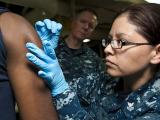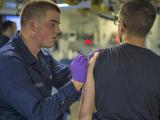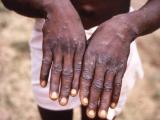Sep 16, 2003 (CIDRAP News) – A voluntary smallpox vaccination policy for the public is likely to produce an inadequate level of protection for the nation in the event of a smallpox attack, according to a recent study based on mathematical modeling.
Researchers used a combination of game theory and epidemic modeling to predict what percentage of people would voluntarily get a shot under various conditions and how this would compare with the "group optimum," the level best for the population as whole. The model showed that, under one set of conditions, only 19% of the population would get a shot, well below the 47% optimum. This would result in 54% more deaths in the event of a smallpox outbreak, according to the model.
"Our results illustrate how the conflict between group interest and self-interest typically causes large differences between vaccine coverage levels that are best for the group and uptake levels that might actually be achieved under a voluntary vaccination program," states the report by Chris T. Bauch of McMaster University, Hamilton, Ont., and colleagues from McMaster and the University of California, Berkeley.
The authors defined the group optimum as the level of pre-event vaccination coverage that minimizes both the risk of death from smallpox and risk of death from vaccine complications. If individuals based their vaccination decisions purely on self-interest, they would weigh the risk of vaccine complications against the risk of a bioterrorist release of smallpox, the report says. The resulting level of coverage, which the authors call the individual equilibrium, can be calculated by using game theory, which predicts behavior in settings where the payoff of a strategy depends on the strategy chosen by others.
The model involved a set of nine variables pertaining to the nature of a smallpox outbreak and the response, such as the probability and scale of a bioterrorist attack, the post-attack vaccination rate, and the average number of secondary smallpox cases caused by each victim. Assuming that the probability of an attack was 1% and that an attack would infect 5,000 people, the model showed that the optimum vaccine coverage would be 47%, while the actual voluntary vaccination rate would be 19%.
The model was tried with 10,000 different combinations of the nine variables. On average, the optimal vaccination rate was 65% and the voluntary rate was 48%. Smallpox mortality was an average of 22% higher with the voluntary approach than with optimal coverage. The researchers assumed that people have no remaining protection from their childhood vaccinations, but assuming some residual immunity has little effect on the results of the model, the report says.
The article notes that polls typically indicate that about 60% of Americans would choose smallpox vaccination if it were available, a considerably higher proportion than predicted by the model. The reason for this discrepancy may be that people have an inflated idea of attack risk, attack size, or the rate at which smallpox could spread, the authors suggest.
The model assumed that individuals would decide about vaccination strictly on the basis of self-interest, but the authors note that religious beliefs and altruism would also influence people's decisions. "Public health education should not ignore appeals to altruism, because, all else being equal, self-interested decision making could lead to seriously suboptimal vaccine uptake levels," they state.
Bauch CT, Galvani A, Earn DJD. Group interest versus self-interest in smallpox vaccination policy. Proc Natl Acad Sci 2003;100(18)10564-7 [Abstract]


















